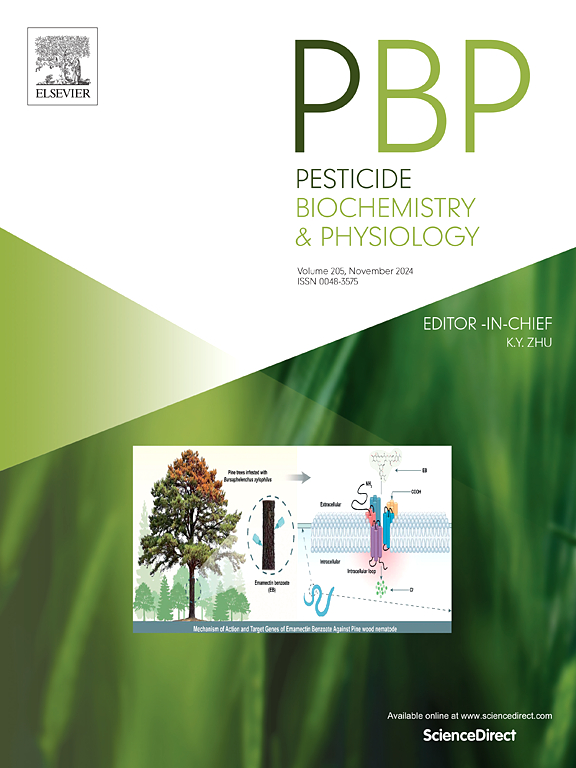以滑囊为靶点的RNAi生物检测揭示了八爪蟾毒蛾防治的潜在靶点
IF 4
1区 农林科学
Q2 BIOCHEMISTRY & MOLECULAR BIOLOGY
引用次数: 0
摘要
八爪虫是一种重要的经济害虫,通常通过使用化学杀虫剂进行控制。RNA干扰(RNAi)技术的引入为生物农药的开发开辟了新的途径,导致鉴定对昆虫生长发育至关重要的各种基因。然而,对八爪鱼靶基因的有效筛选仍然有限。本研究详细探讨了burssi神经肽在八爪鱼中的功能作用。空间分布和发育特征分析表明,两个主要的法氏囊亚基HvBurs-α和HvBurs-β在中枢神经系统中表现出特定的表达模式,特别是在一龄幼虫阶段达到峰值。这些基因的靶向RNAi导致mRNA水平急剧降低,导致化蛹和羽化率降低,以及几乎完全畸形,特别是在翅膀发育方面。在二龄和四龄幼虫身上进行的RNAi实验显示,成年幼虫的鞘翅和后翅的大小都显著缩小,后翅严重萎缩,缺乏伸展的能力。此外,dsRNA与阿维菌素或高效氯氰菊酯等化学杀虫剂联合使用会增加幼虫死亡率,并对化蛹率和羽化率产生不利影响。重要的是,针对HvBurs-α和HvBurs-β的dsRNA应用并未对掠食性瓢虫Harmonia axyridis产生不利影响,表明其具有良好的安全性。总之,这些发现强调了Bursicon在H. vigintioctopunctata翅膀发育中的关键作用,并强调了它作为基于rnai的生物农药策略的有希望的靶点的潜力,为管理害虫种群及其迁徙行为提供了一种新颖而环保的方法。本文章由计算机程序翻译,如有差异,请以英文原文为准。

RNAi bioassays targeting bursicon reveal potential targets for pest control of Henosepilachna vigintioctopunctata
Henosepilachna vigintioctopunctata represents a significant economic pest, typically controlled through the use of chemical insecticides. The introduction of RNA interference (RNAi) technology has opened new avenues for biopesticide development, leading to the identification of various genes that are crucial for the growth and development of insects. However, the efficient screening of target genes in H. vigintioctopunctata remains limited. The present study provides a detailed investigation into the functional role of the neuropeptide Bursicon in H. vigintioctopunctata. The analysis of spatial distribution and developmental profiles demonstrated that two primary Bursicon subunits, HvBurs-α and HvBurs-β, exhibited specific expression patterns in the central nervous system, particularly peaking during the first-instar larval stage. Targeted RNAi of these genes led to a dramatic reduction in mRNA levels, resulting in reduced pupation and eclosion rates, along with nearly complete malformation, particularly concerning wing development. Experiments involving RNAi on second- and fourth-instar larvae showed significant reductions in the size of both elytra and hindwings in the adult forms, with the hindwings suffering severe shrinkage and lacking the ability to extend. Additionally, the combination of dsRNA treatment with chemical insecticides like avermectin or beta-cypermethrin increased larval mortality and adversely affected pupation and eclosion rates. Importantly, the application of dsRNA aimed at HvBurs-α and HvBurs-β did not adversely affect the predatory lady beetle Harmonia axyridis, suggesting a promising safety profile. Altogether, these findings underscore the critical role of Bursicon in wing development in H. vigintioctopunctata and highlight its potential as a promising target for RNAi-based biopesticide strategies, providing a novel and environmentally friendly approach to managing pest populations and their migratory behaviors.
求助全文
通过发布文献求助,成功后即可免费获取论文全文。
去求助
来源期刊
CiteScore
7.00
自引率
8.50%
发文量
238
审稿时长
4.2 months
期刊介绍:
Pesticide Biochemistry and Physiology publishes original scientific articles pertaining to the mode of action of plant protection agents such as insecticides, fungicides, herbicides, and similar compounds, including nonlethal pest control agents, biosynthesis of pheromones, hormones, and plant resistance agents. Manuscripts may include a biochemical, physiological, or molecular study for an understanding of comparative toxicology or selective toxicity of both target and nontarget organisms. Particular interest will be given to studies on the molecular biology of pest control, toxicology, and pesticide resistance.
Research Areas Emphasized Include the Biochemistry and Physiology of:
• Comparative toxicity
• Mode of action
• Pathophysiology
• Plant growth regulators
• Resistance
• Other effects of pesticides on both parasites and hosts.

 求助内容:
求助内容: 应助结果提醒方式:
应助结果提醒方式:


